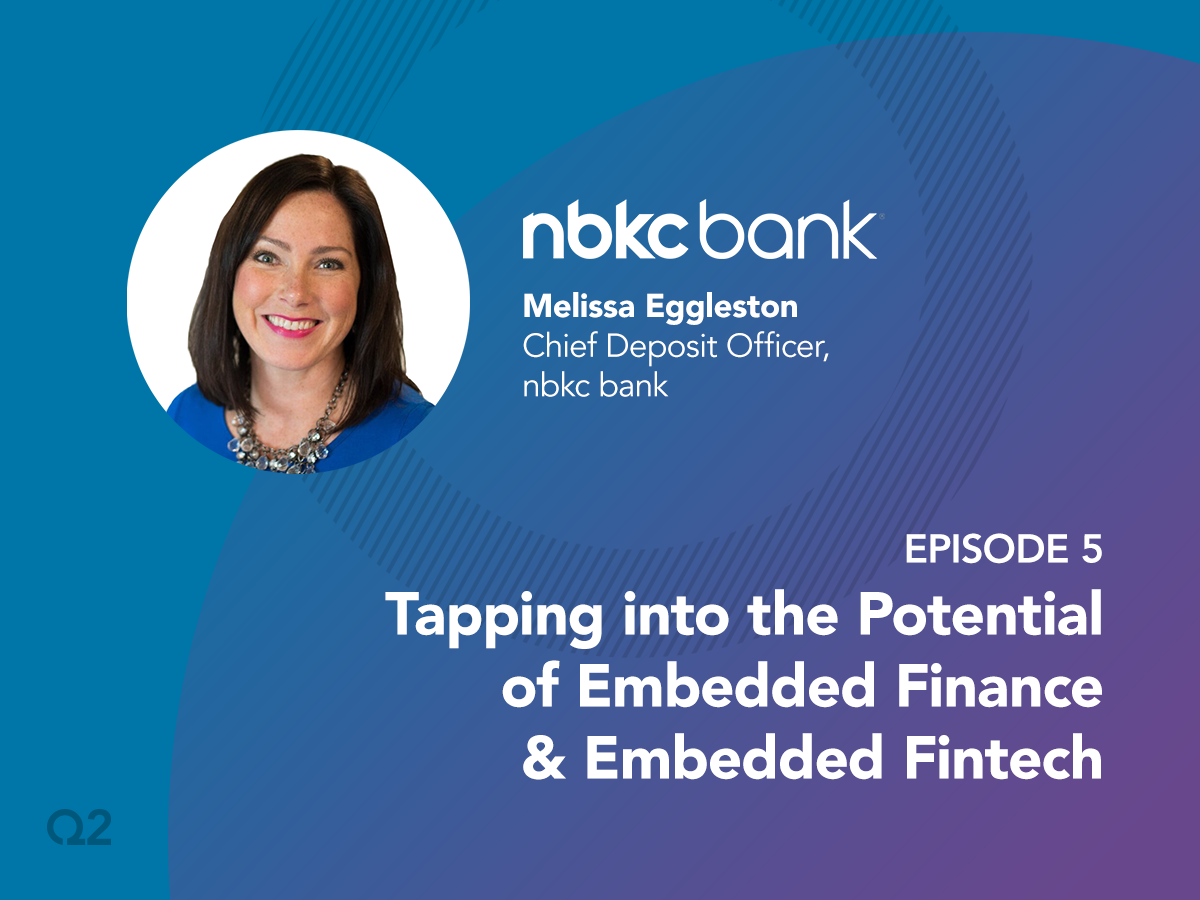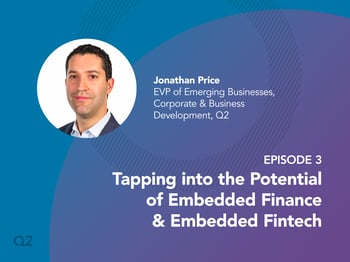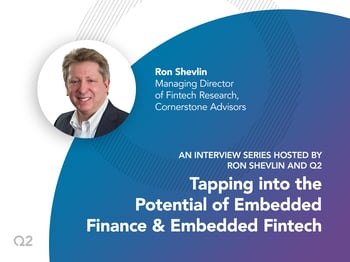Episode 5 – Melissa Eggleston, Chief Deposit Officer at nbkc Bank
In this episode, Ron and Melissa discuss nbkc’s embedded finance strategy and detail how it overcame challenges associated with compliance, partner selection, and more.
Watch the full episode here.
Ron Shevlin:
Hi, and welcome to Tapping into the Potential of Embedded Finance, sponsored by Q2. I'm your host, Ron Shevlin, Director of Research at Cornerstone Advisors and a senior contributor at Forbes where I write the Finech Snark Tank Blog. My guest today is Melissa Eggleston, the Chief Deposit Officer at nbkc Bank in Kansas City. Prior to joining NBKC about five years ago, Melissa was the Director of Private Banking at Alterra Bank, and before that, a Vice President at First Citizens Bank in Kansas. Melissa, thanks a lot for joining me today.
Melissa Eggleston:
So happy to be here, Ron.
Ron Shevlin:
Great. So I guess the beginning is always a good place to start for conversations like this. And I'd like to ask you to start by telling us a little bit about how did NBKC come to determine that embedded finance or banking as a service was a strategic opportunity for the bank?
Melissa Eggleston:
Well, as you can imagine, community banks are looking for new and exciting ways to stay relevant with customers and also just maintain market share. So from a strategic perspective, we decided about five years ago, actually our CEO, Brian Unruh, who I know you're familiar with Ron, he encouraged us all to stop going to banking conferences and really understand what it looked like to be part of fintech, understand that market, and we always have felt like we've been pretty progressive. So as it related to that, we just started having lots of conversations with companies, big and small, people who are doing really interesting things in technology, specifically banking, delivering new products or services to consumers and small businesses. And really that led us down a path of saying, "We can absolutely do this. We should be in this market." And really went to learning and understanding and saying, "What could this look like as a part of our business to help increase revenue, increase low-cost deposits, and then obviously just be a part of the ecosystem?"
Ron Shevlin:
Melissa, when I talk to a lot of banks about embedded finance and banking as a service and the opportunity there, I think there's a lot of confusion in the market and I think it's hard to impose a definition on it, but I often describe it to bankers as it's a distribution channel, it's white-label banking. You're providing your services through somebody else who helps you reach a lot of customers that you couldn't reach by yourself. Now, I find that a lot of bankers don't like that because they feel like they're losing their brand identity. They feel like they're losing the connection to the customer. Was that an issue to your bank?
Melissa Eggleston:
Well, I wouldn't say it was an issue, it was an awareness. So from a strategic perspective, if you're gonna go on down the banking as a service and really working in the background, which is what we do with our partners, you have to be okay with being in the background. And it has not taken away from our brand, it's just another component of who we are as a financial institution. We are the bank behind large brands who want to deliver services and products to their customers, and we're okay with that. Actually I think there's strength in that and we continue to build our own bank brand, but there's a give and take at any strategic decision, and that give was that we're going to make sure the regulatory rules of the road are intact and that we also do all the things to make our partners successful.
Ron Shevlin:
Melissa, if I can, I'd like to get into the weeds of this BaaS or partnership kind of world here. How does NBKC identify potential partners? Do fintechs and non-financial brands come to you? Do you have a business development team that goes out to identify potential partners? How does it actually work?
Melissa Eggleston:
Sure. So we've been really, anytime you start anything new, you make the rules up as you go around how you're going to get new prospects, how you're going to solidify clients and things along those lines. Thankfully, Q2 has been a really amazing, solid partner from the beginning. They have a sales team, folks that are out talking to people. And on the bank side, I mean, we just took meetings. We get reached out to all the time by new, existing fintechs, companies who want to bring a financial product forward, who really don't have a technology platform yet. And so it's really saying yes early to talking to prospects. I'd say the other thing, you just gained some reputational halo, if you will, from being in the industry and really putting yourself out there and talking about the things that you think you do well. We've had some great halo effect there with some of our VC partner friends, along with attorneys and other trade organizations that frankly play in this market and support this ecosystem.
Ron Shevlin:
With a decent and growing number of banks in the BaaS space, how do you differentiate yourself and compete with the other potential providers?
Melissa Eggleston:
Yeah, it's interesting. Everybody's business is unique, even in banking. It's harder for banks to make money these days, but with that comes different strategies. And our strategy has always been to be really available to our partners. I would say one of the ways that we set ourselves apart is we interact in the relationship. We have an entire partnership team that their daily duties are to make sure that we have the right cadence with our fintech partners. The other thing I'd say is we're different in the fact [inaudible] running our bank charter. I know there's some of that that exists where the bank is very, very hands off. We find that that can actually be a detrimental thing to a fintech. I actually think a fintech thinks that that can be positive. From our lens, just knowing what it looks like to interact with our regulators who we have a very good, open relationship with, it's really good for the bank to know what it looks like for their partners in those programs that aren't at risk because the bank is removed.
So we find that to be a very positive thing. I would say that's probably a very large differentiator. The other piece to the puzzle here is we have executive and board buy-in, so the decision makers are generally on those calls, on those meetings, and accessible to any of the programs, which is really important when these programs actually or partners, want to move forward something quickly and have some type of dialogue with folks who can actually move the ball forward for them.
Ron Shevlin:
Is there specialization that you do from a product perspective? Whoops. Pause there. I lost my video for a second there. I'll pause and then get this question out. So what do you see in terms of specialization? Are you focusing in on payment products versus lending? Are you providing the whole range of products? And how do you see that evolving from an embedded finance perspective over the next couple years?
Melissa Eggleston:
Yeah. So from banking as a service today, most of our partners are providing some type of deposit account product out in the market to consumers. That really is where our expertise lies today. This is an obvious statement, we are a bank. So we do deposit gathering, lending, it's just in our traditional brand, deposit gathering, lending, and then actually we have a really successful home loan department as well. So we intend to extend our expertise to additional areas. I think there's a very large opportunity with the SMB market as it relates to neobanks coming on board and really being a place for small businesses to operate more efficiently and live. I would say lending as a service is something we're very, very interested in. We haven't had the right fit thus far.
Several of our partners, it's important to them to extend their reach from just deposit accounts. So we know that those are areas that we want to play in. There is a large opportunity, I believe, in the payment space where the bank could be in the middle of some type of payment flow and transaction. For that to probably make sense for us, it continues to be around risk/reward. There's a whole lot of risk in the payment space today. There's risk involved in all of this banking as a service, whether it be lending, deposits, or payments. So, it just has to fit the right strategic revenue model for us, and then also risk appetite.
Ron Shevlin:
From an industry perspective, Melissa, how big do you think the BaaS opportunity is? And I'm not asking about it in terms of dollars, but five years from now, how many banks do you think will be in the embedded finance space providing BaaS services?
Melissa Eggleston:
If you would asked me that five years ago, I probably would have a different answer. Actually, I think that the more demand and fintechs looking for banks to provide this service is going to drive financial institutions to say, "We should probably get in that game." It is a revenue driver and there's value in these deposits and these relationships with our partners. And so I anticipate as margin compression continues to happen within the community banking and just banking industry, this will be an avenue that banks strategically say, "Should we do this? What kind of expertise is needed?" And more banks will say yes to at least trying it. Whether it be a long-term strategy or not for some of these institutions, that'll be seen. But from our perspective, we're all in. This is an area that we know will continue to grow and we're excited about what it can do for our business and our partners' business.
Ron Shevlin:
Yeah. The embedded finance space has really, I think at least two sides to it. One being fintechs who are looking for bank partners to provide services, but also growingly, of course, is the non-fintech or the non-financial brands like an Uber, a Lyft, Nike, whoever looking to get into financial services. And those are maybe some of the big companies, but from a bank's perspective, Melissa, should they be looking at their small business banking efforts as opportunities to provide BaaS services to their small business customers and not just banking services?
Melissa Eggleston:
Oh, sure. I think anytime you have a brand who has reach, you start thinking about what it looks like to be a successful fintech, what we would really characterize as a fintech, a neobank, it is about acquiring customers, maintaining those customers, and then driving value to those customers over time. Some of these large brands, they already have a customer base. They have an active audience, they have a whole group of people that are marketable today. When you think of Apple, what it looks like, "Hey, do you want to use Apple Pay?" It's just part of a strategy where they know that they can get more from people who already like and trust them.
So I believe that will continue to be a distribution point. I think as brands get larger, continue to look for additional revenue opportunities, they will say, "How can we deliver more value?" Because that's really what it's about here is more value to a customer where they're brand loyal and make it compelling. And sometimes that comes in the way of a savings account, saving for a rainy day, some type of specialized checking account or frankly, some type of loan that could help weather a challenging time for them in their lives. So I think that's the future, and I think any brand that is looking to develop deeper relationships with their customers, they will absolutely turn over those rocks.
Ron Shevlin:
Yeah. A lot of the financial institutions I talked to about embedded finance and providing BaaS services always refer back to compliance and regulatory concerns. What regulatory compliance concerns does NBKC have now? You've been in this for years. How do you deal with those challenges? What are the particular challenges that you still think exist there?
Melissa Eggleston:
Sure. Well, we're a heavily regulated industry, that's probably obvious. But one of the things that we did early on was develop a very good relationship and open dialogue with our regulators, as good as I think you can have that at any point when you're trying to run a business and do something new, new to them, new to the market, and could be seen as a higher risk. So, we've been through a couple regulatory cycles, so we know what that looks like. We certainly continue to make sure that any blind spots we have attention to, but it's the big things. Any time you have money moving, there is always some type of AML risk like around VSA and AML, anti-money laundering. Just making sure that we know who the sender and the receiver are of these funds.
Anybody who's been in financial services knows that that's a really large deal. There's also a high impetus put on knowing your customer, which is also making sure we properly identify people who come on the platform. Those big pieces are probably what is going to continue to be the pressure points around our regulators. They won't go away. Those are big pieces for the bank in general, even outside of banking as a service. And then the other big piece is making sure you have the right type of controls and have identified risks around the operation of any program. That's just good business, whether you're in banking or not, but that also allows us to stay on the right side of any regulatory concerns or issues.
Ron Shevlin:
So this might be a really stupid question on my part, but all the regulatory concerns and compliance concerns that you just raised makes me wonder, how is it any different than a normal bank dealing with all of that money movement and customers who aren't dealing with an intermediary like a fintech or a brand? Is it really any different?
Melissa Eggleston:
I would say the things that regulators look at aren't different, the scope in which they look at it is a little more detailed. And I would say that because really, our partners, whether it be an actual neobank fintech or a large brand who's extending a financial product, they're an extension of the bank. Ultimately, if there's a regulatory challenge or an issue, our regulator isn't going to go to our partner, our regulator comes knocking on our door and says, "Hey, tell me what kind of oversight you've had here and what kind of conversations you've had, and tell me what the status is."
And so that's why it becomes so important for us to maintain that regular rapport and relationship. But to your point, Ron, they're looking at the same pieces. Us operating a bank and us operating a banking as a service within the bank, they're similar requirements. And fraud is a very, very hot topic among the banking industry and then even just banking as a service. People are really smart and they know how to defraud banks and fintechs for money.
Ron Shevlin:
Is the extra focus on the part of the regulators due to the fact that this is a relatively new type of arrangement? Do you think that it'll abate over time as it becomes more accepted and more popular?
Melissa Eggleston:
I think it is because it's new, newer if you will. There are a lot of banks that have been in this space before NBKC five years ago. And we have different regulating bodies, so not all regulators are created equal. Our regulators have been very, very interested in learning, understanding, and frankly, walking alongside us to make sure we understand some of the really large risks that maybe they see that wasn't exactly clear on the onset. But I believe regulators are moving in the right direction. I think they're absolutely saying, "Banking is changing." And community banks, banks under the Durbin Act are basically figuring out ways to continue to stay relevant, make money, and continue to be profi able and build shareholder value, and this is a way that we do that.
Ron Shevlin:
Yeah. So last question for you, Melissa. I appreciate all the time you've taken so far. I've got one more question to ask you. And I want you to forget for the moment that I'm asking you to potentially advise potential competitors, but what advice would you give to a bank who was just first launching BaaS services?
Melissa Eggleston:
That's loaded. So you're making me go back to when we started this thinking about ... it was fun because it was a startup for us. That's really essentially what we did. We just said, "We're going to go do this." And we've learned a whole lot. Expertise is really important. And when I say expertise, having people within your team who understand the risks of money movement, and when I say that, talking about ACH, any payment rail, frankly, where the bank and the fintech or partner are at risk of vulnerability, i.e. Losing money, something along those lines. I think there needs to be a pretty high aptitude in the compliance group to figure out a way to get to yes. Compliance people get a bad rap, unfortunately.
Sometimes they're like the place of no, that's where things stop. And fortunately that hasn't been my experience at NBKC, which has been really important because when you do new things, certainly new risks appear and you have to figure out ways to mitigate that. And the only way that that can occur is if you have a well-rounded compliance group who gets it. Board-level buy-in and visibility has been very, very important for us to be super successful here. This is not a short-term strategy. You can't just decide one day that you're going to go be a bank who provides banking services to brands or any partner and do that in six months. There's a little bit of a long pull here, and strategic commitment is really important as well.
Ron Shevlin:
Great. Well, Melissa Eggleston, Chief Deposit Officer, NBKC Bank. Thank you very much for spending some time with us today. Thank you everybody for dialing in listening in on this, another episode of Tapping into the Potential of Embedded Finance. See you in the next episode.





